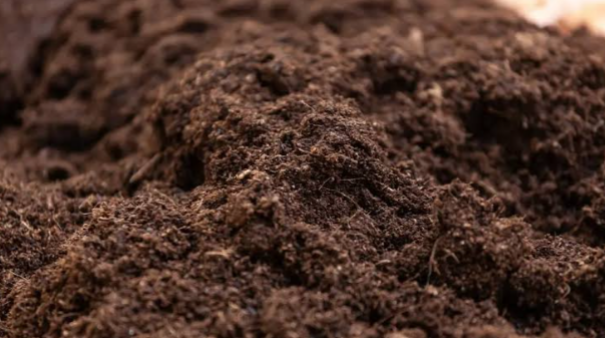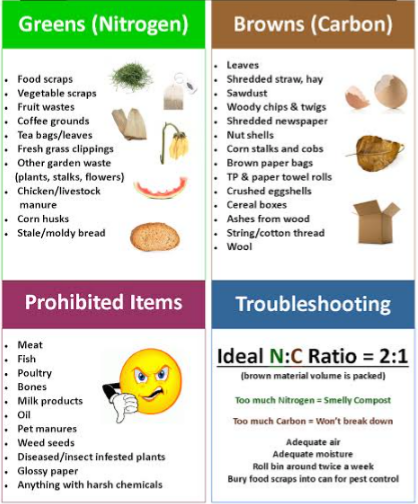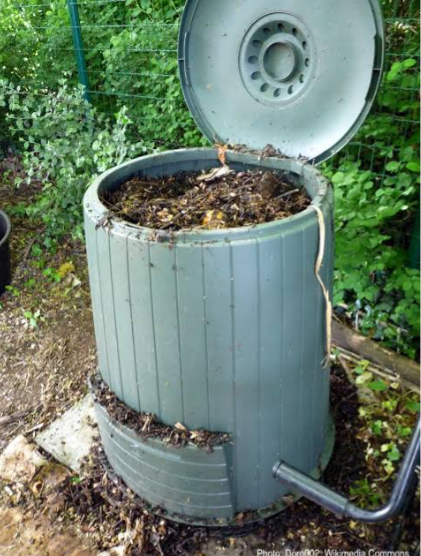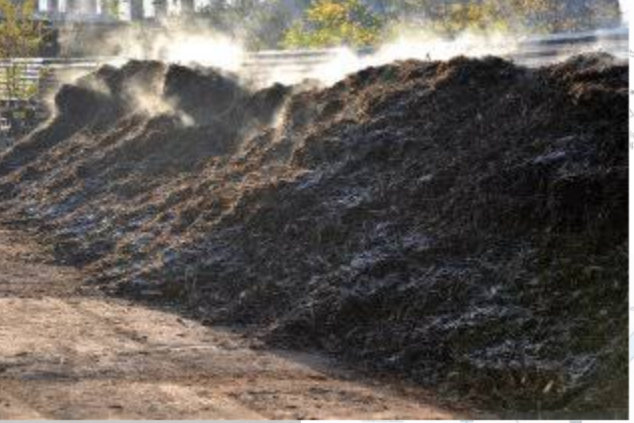
Composting is a recycling process. It can be defined as a controlled, aerobic (oxygen-required), decomposition process where organic materials are converted into a nutrient-rich soil amendment. The end product of composting is compost. Farmers often refer to compost as “black gold,” because it is rich in nutrients. It can be used for gardening, horticulture, and agricultural purposes.
Compost is the soil-like product of the decomposition of organic materials. During the process of composting, Microorganisms are used to break down the materials that are compiled to form the compost pile. Carbon and Nitrogen are the two most important nutrients for microbial growth during composting. The microbs uses carbon and nitrogen to grow and reproduce, water to digest materials, and oxygen to breathe.
At higher C:N ratios, microbial activities are slowed down whereas at lower C:N ratios, their activities are speed up and they release ammonia.
BENEFITS OF USING COMPOST
1. Mature compost stores well and it is free of unpleasant odors, and easier to handle
2. It is less bulky than raw organic wastes.
3. Compost is used as soil amendment, seed starter, and natural fertilizer, depending on its characteristics.
4. Composting can used to reduce or eliminate weed seeds and plant pathogens in organic residues.
5. Compost helps improving soil biological, chemical, and physical characteristics:
6. It helps increase microbial activities in the soil
7. It helps increases cation exchange capacity of the soil.
8. It improves soil structure in clayey soils
9. It improves water retention in sandy soils
10. It reduces bioavailability of heavy metals
11. Compost can be used as potting mix
12. Compost is used to help grow plants or as mulch,
13. Reduce environmental pollution caused by kitchen, agricultural and industrial wastes by diverting food and yard waste from landfills to useful compost
14. The food and yard waste from landfills increases the build up of methane gas in the atmosphere which result in greenhouse gas emissions. Therefore, converting the materials into compost reduces the gas in the atmosphere.
15. Compost improves soil health
16. Composting helps to recycle nutrients 17. Composting mitigates the impact of droughts.etc.
INGREDIENTS OF COMPOST PILE

Ingredients of the compost pile include:
browns, greens, water, and oxygen
BROWNS ( These are the carbon-rich materials):
When the ratio of carbon-rich material, or browns is too high in the pile, it will result in a slow decomposing and very dry pile.
Cardboard, shredded newspaper, paper, paper towels
Sawdust, woodchips
Dead leaves and yard clippings
GREENS ( These are the nitrogen-rich materials):
When the ratio of nitrogen-rich materials (greens) are too high in the pile, this will result in a slimy, wet pile with an unpleasant odor.
Food wastes like banana peels,
Fruit and vegetable trimmings
Coffee grinds and filters
Eggshells
Fresh yard clippings such as such as grass clippings and leaves,
Other ingredients and materials needed for composting include: recycling organic materials, manure, beneficial organisms, such as bacteria, protozoa, nematodes, worms and fungi, Urine, Water etc.
Tools like spade, wheelbarrow, Thermometer
Tester, drums, enclosed containers and sacks etc are needed to complete the composting process.
FACTORS TO CONSIDER IN COMPOST MAKING
1. To start composting, the farmer must first know the materials that can be composted: organic materials or carbon-based materials are needed.
2. The compost pile must contain browns, greens, water, and oxygen.
3. The right materials must be lied in the pile at the right ratio inorder to provide the nutrients in the pile.
4. The size of the items in a compost pile should be put into consederation. If pieces of compost materials are too large, they will take a longer time to break down. But if the materials are shredded into smaller pieces, they would have higher surface area to allow for decomposition, which will help the compost mature faster.
5. The following items should not be included in composting “Kitchen waste such as fish or meat scraps, dairy products, ” due to odor and pest attraction, waste containing chemicals, pesticides, Household items such as coal and charcoal ash, along with pet waste, Perennial Weeds and grease or fat
6. Need for naturally occurring organisms like earthworms, bacteria, fungi, sowbugs, and nematodes and other organisms that live in soil to help broken down the materials in the compost pile
7. Need for occasional turning of the compost to aerate and speed up the overall decomposition process.
8. Compost pile must be in the right ratio of carbon to nitrogen (30:1) and with adequate moisture. This will produce enough heat during decomposition to kill many pathogens and seeds, though it is advisable not to use diseased plant matter and weeds that have gone to seed for composting.
9. Compost piles need water and oxygen to provide for organisms that aid in decomposition process.
The ideal location for compost making is a dry and shady spot. In areas where there is heavy rain, compost should be protected from the rain water so that it does not become soggy. While in sunny periods, it should be protected so as not to become dried up
TYPES OF COMPOSTING METHODS
Composting can be done indoor or outdoor.
There are two main types of backyard composting : Open Air Composting (cold composting also known as passive composting and hot composting also called active composting), stack method, pit method, Bin,Trench Composting, Vermicomposting, windrow, and in-vessel systems
A. DIFFERENCES BETWEEN COLD COMPOSTING AND HOT COMPOSTING
The two types of open air composting which are cold and hot composting methods differ from one another in the following ways:

1. Using cold composting, organic matter are broken down slowly, while in hot composting, organic matter are broken down faster.
2. In cold composting, Mother Nature is allowed to carry out the decomposition process with minimal intervention from the farmer. While in hot composting, the attention of the farmer is needed to keep carbon and nitrogen in the optimum ratio for the organic waste to decompose
3. No need of regulating the aeration , or monitor the moisture levels in cold composting, but in hot composting, the right balance of air and water are required to attract the organisms that thrive in an oxygen-rich environment.
4. Cold composting is best used when the amount of organic waste is small and the farmer has no time to tend to the process. While hot composting is used when the organic wastes are much and it takes a longer time to get the result.
5. The temperature in cold composting may not be high enough during the decomposition process to kill off all pathogens. Some lingering harmful pathogenic bacteria, fungi, protozoa, worms, and other parasites as well as weed seeds might still be found in the finished product. While in hot composting, the high temperature of the pile will destroy most weeds, plant diseases, pesticides, and herbicides, plus any bug larvae or eggs in the finished product
6. Cold piles may produce odour or wetter than hot piles
7. Cold composting process is an anaerobic process, meaning that the materials are broken down by microorganisms that thrive in an oxygen-deprived environment. While hot composting takes effect in aerobic process.

B. DIRECT COMPOSTING : It is also called direct trench composting. It is the oldest and most effective method of composting. It involves simply digging a hole or trench in the ground and burying the scraps. Only fruit and vegetables are materials that can be used in direct composting. The reason is because the farmer can be at risk of it being dug up by all sorts of garden animals such as birds, rodents and other animals.
The limitation of this method is that without chopping the materials into smaller pieces, it will take a long time for them to decompose. And if materials eatable by animals are used, the farmer will have to keep digging new holes.
A major advantage of the method is that abundance of worms are produced which will help improve the soil.
C. STATIC PILES: There are two types of static pile methods.
1.Static Pile/Bin with Passive Aeration
2. Static pile with active aeration
STATIC PILE /BIN WITH PASSIVE AERATION.

Passively aerated static piles is also called bin method. These piles rely on passive aeration rather than active aeration to maintain optimal temperature and oxygen levels. By Passive aeration, warm air or heated is created by microbial activity during decomposition process. The warm air rising to the top of the pile, at the same time, cool air is drawn from the top of the pile through the sides to the bottom of the pile which replaces the hot air. This is called the “chimney effect.” The pile should be properly mixed occationally by turning the organic materials. During the mixing, farmers should ensure there is enough free air space throughout the pile to support aeration. Wood chips can be mixed with the pile, this will help create a less dense pile for oxygen to flow. About three to five Bins constructed from materials such as wire, wood, and enclosed barrels or tumblers are needed to start the composting and for mixing the materials.
STATIC PILE WITH ACTIVE AERATION

In this second method, blower systems with pipes are installed to move air beneath or inside the pile. When air is blown through pipes from beneath, this is called positive aeration. But when air is down from the top through the pile, this is called negative aeration. The piles may be covered to help control the pile temperature and moisture level. The advantages are: this method of composting speeds up the composting process by carefully controlling the pile conditions and large quantities of materials and all types of materials can be used.
D. WINDROW

The windrow method involves creating long, tall piles of organic matter or biodegradable waste. Windrows should be turned periodically or have perforated pipes underneath them to allow air flow into the materials. Small to large volumes and a wide variety of materials can be composted using this method, which makes it adaptable to many scales and sites for composting. Windrow composting often requires equipment such as front-end loaders, excavators, or windrow turners.
E. IN-VESSEL COMPOSTING

In-Vessel composting is a method of production of compost in a sealed container. The container can be a vessel, such as a drum, silo, concrete-lined trench, or other enclosed equipment that can help speed the composting process and the decomposition of organic matter. The method can accommodate varieties of organic materials without taking up much space. The major advantage of this method is that it keeps smells off the area during the composting process. The materials are mechanically turned or mixed in the vessel to ensure proper aeration.
F. VERMICOMPOSTING :
Vermicomposting means making compost with worms. By definition, vermicompost is a nutrient-rich organic fertilizer and soil conditioner in a form that is relatively easy for plants to absorb. Worm composting is an aerobic processes – they require oxygen (O2) to function. The most commonly used composting worm is a species of the red wrigglers called tiger worm or red tiger worm (Eisenia fetida). Others include: red earthworm (Lumbricus rubellus), white worms, Eisenia hortensis ( European nightcrawlers), Eudrilus eugeniae ( African Nightcrawlers) Perionyx excavatus (blue worm) earthworms etc.
The composting materials are piled up and the worms are introduced on top of the materials. They burrow into the compost pile and start the decomposing process. Aeration and turning of the vermicompost pile is done by the worms.
Most of the energy used in the composting is tied up in the worm biomass. Composting worms hate heat. Red wiggles will either escape from the compost heat or die within it.
.
